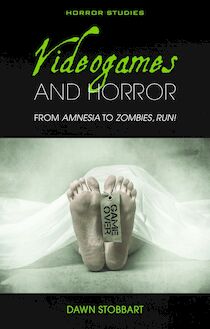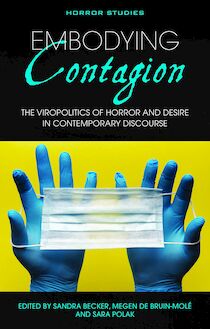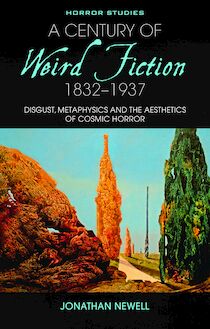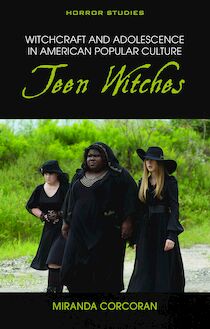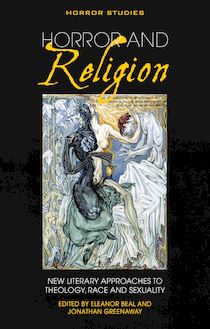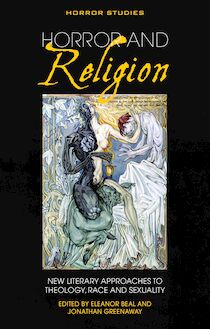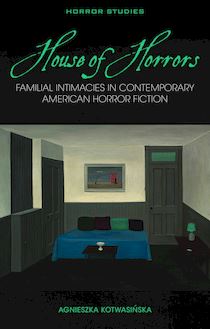-
 Univers
Univers
-
 Ebooks
Ebooks
-
 Livres audio
Livres audio
-
 Presse
Presse
-
 Podcasts
Podcasts
-
 BD
BD
-
 Documents
Documents
-
- Cours
- Révisions
- Ressources pédagogiques
- Sciences de l’éducation
- Manuels scolaires
- Langues
- Travaux de classe
- Annales de BEP
- Etudes supérieures
- Maternelle et primaire
- Fiches de lecture
- Orientation scolaire
- Méthodologie
- Corrigés de devoir
- Annales d’examens et concours
- Annales du bac
- Annales du brevet
- Rapports de stage
La lecture à portée de main
Vous pourrez modifier la taille du texte de cet ouvrage
Découvre YouScribe en t'inscrivant gratuitement
Je m'inscrisRe-envisaging the First Age of Cinematic Horror, 1896-1934 , livre ebook
Découvre YouScribe en t'inscrivant gratuitement
Je m'inscrisEn savoir plus
Vous pourrez modifier la taille du texte de cet ouvrage
En savoir plus

Description
This is a ground-breaking exploration that runs generally against the critical grain in identifying a burgeoning production of films of fear and horror before the admission of the horror film genre per se. It is a study that reveals and emphasises the formative and innovative power of film, from Georges Méliès’s Le Manoir du Diable (1896) to Edgar G. Ulmer’s superbly reflexive The Black Cat (1934). With its focus on twenty-one key films, and referencing other relevant productions, the present study involves an inclusive and sensitive approach. It reveals an awareness of the heterogeneity of horror production with the discussion spanning the period of the invention of movies, the expansion from single-reelers to longer and continuous productions, and the advent of talkies. Stepping beyond the bounds of Anglo-American studios, in its seven chapters the book involves the work of directors from France, Spain, England, Moravia, Germany, Italy, Denmark, Mexico and the USA, to consider and compare films that have not previously received serious attention.
Contents:
List of Illustrations
Acknowledgements
Introduction
1. Satanic seizure and the Crimson Smoke of Fear
2. Torture Rooms and the Diva of Death
3. Omnibus to Hell and the Inescapable Carriage
4. Tickets to the Madhouse
5. Experimental Delirium
6. Mind the Gap! Fear on the verge and after Sound
7. Sadean Masterpieces, Dread and Slaughter
List of Illustrations
Acknowledgements
Sujets
Informations
| Publié par | University of Wales Press |
| Date de parution | 14 novembre 2018 |
| Nombre de lectures | 0 |
| EAN13 | 9781786833372 |
| Langue | English |
| Poids de l'ouvrage | 2 Mo |
Informations légales : prix de location à la page 0,2850€. Cette information est donnée uniquement à titre indicatif conformément à la législation en vigueur.
Extrait
RE-ENVISAGING
THE FIRST AGE OF
Cinematic Horror
1896-1934: QUANTA OF FEAR
HORROR STUDIES
Series Editor
Xavier Aldana Reyes, Manchester Metropolitan University
Editorial Board
Stacey Abbott, Roehampton University
Linnie Blake, Manchester Metropolitan University
Harry M. Benshoff, University of North Texas
Fred Botting, Kingston University
Steven Bruhm, Western University
Steffen Hantke, Sogang University
Joan Hawkins, Indiana University
Agnieszka Soltysik Monnet, University of Lausanne
Bernice M. Murphy, Trinity College Dublin
Johnny Walker, Northumbria University
Preface
Horror Studies is the first book series exclusively dedicated to the study of the genre in its various manifestations - from fiction to cinema and television, magazines to comics, and extending to other forms of narrative texts such as video games and music. Horror Studies aims to raise the profile of Horror and to further its academic institutionalisation by providing a publishing home for cutting-edge research. As an exciting new venture within the established Cultural Studies and Literary Criticism programme, Horror Studies will expand the field in innovative and student-friendly ways.
RE-ENVISAGING THE FIRST AGE OF
Cinematic Horror
1896-1934: QUANTA OF FEAR
DAVID ANNWN JONES -->
UNIVERSITY OF WALES PRESS CARDIFF
© David Annwn Jones, 2018
All rights reserved. No part of this book may be reproduced in any material form (including photocopying or storing it in any medium by electronic means and whether or not transiently or incidentally to some other use of this publication) without the written permission of the copyright owner except in accordance with the provisions of the Copyright, Designs and Patents Act. Applications for the copyright owner s written permission to reproduce any part of this publication should be addressed to the University of Wales Press, University Registry, King Edward VII Avenue, Cardiff CF10 3NS.
www.uwp.co.uk
British Library Cataloguing-in-Publication Data
A catalogue record for this book is available from the British Library.
ISBN 978-1-78683-335-8
eISBN 978-1-78683-337-2
The right of David Annwn Jones to be identified as author of this work has been asserted in accordance with sections 77 and 79 of the Copyright, Designs and Patents Act 1988.
The publisher has no responsibility for the persistence or accuracy of URLs for any external or third-party internet websites referred to in this book, and does not guarantee that any content on such websites is, or will remain, accurate or appropriate.
Cover image: Scene from White Zombie (1932). © With permission of Andrew Lifford-Stills Collection.
For Kevin Brownlow, in admiration; for Lesley and for the younger generation: Rebecca, Andrew, Calum, Jenny, Alasdair, Miranda, Miles, Finlay and Erin. May all your best chills be thrills.
Contents
Acknowledgements
List of Illustrations
Introduction
1. Satanic Seizure and the Crimson Smoke of Fear
Georges Méliès s Le Manoir du Diable / The Haunted Castle (1896) and Segundo de Chomón s La Légende du Fantôme / The Legend of the Ghost (1907)
2. Torture Rooms and the Diva of Death
D. W. Griffith s The Sealed Room (1909), Alice Guy Blaché s The Pit and the Pendulum (1913) and Nino Oxilia s Rapsodia Satanica / Satanic Rhapsody (1915)
3. Omnibus to Hell and the Inescapable Carriage
Richard Oswald s Unheimliche Geschichten / Tales of the Uncanny (1919), Victor Sjöström s The Phantom Carriage (1921) and Paul Leni s Das Wachsfigurenkabinett / Waxworks (1924)
4. Tickets to the Madhouse
Abel Gance s Au Secours! / Help! (1923), Rex Ingram s The Magician (1927) and Paul Leni s The Cat and the Canary (1927)
5. Experimental Delirium
Benjamin Christensen s Häxan / Witchcraft through the Ages (1922), Castleford Knight s Prelude to Rachmaninoff in C Sharp Minor (1927), Jean Epstein s La Chute de la Maison Usher / The Fall of the House of Usher (1928) and Theodor Dreyer s Vampyr (1932)
6. Mind the Gap! Fear on the Verge and after Sound
Benjamin Christensen s Seven Footprints to Satan (1929), Roland West s The Bat Whispers (1930) and Jack Conway s The Unholy Three (1930)
7. Sadean Masterpieces, Dread and Slaughter
Irving Pichel and Ernest B. Schoedsack s The Most Dangerous Game (1932), Victor Halperin s White Zombie (1932), Ramón Peón s La Llorona / The Wailing Woman (1933) and Edgar G. Ulmer s The Black Cat (1934)
Afterword
Glossary
Filmography
Bibliography
Acknowledgements
I WOULD LIKE to express my sincere thanks to Sarah Lewis of University of Wales Press for her kind assistance and patience in the preparation of this book. The timely advice, friendly offices and hard work of Dr Xavier Aldana Reyes, the series editor, in helping me at an extremely busy time for himself, also proved invaluable. As ever and, as in the case of all my projects, the support and commitment of Dr Lesley Newland, my wife, has enabled the completion of this work.
List of Illustrations
1 A detective (Reinhold Schünzel), who has infiltrated a Suicide club , suffers hallucinations of its president (Conrad Veidt) in Richard Oswald s Unheimliche Geschichten / Tales of the Uncanny (1919).
2 Robert, a cavalier s valet (Georges Méliès), repulses Mephistopheles (Jules-Eugène Legris) with a crucifix in Georges Méliès s Le Manoir du Diable / The House of the Devil (1896).
3 The victorious detective (Reinhold Schünzel) finally traps the president of the Suicide club (Conrad Veidt) by using the villain s own devices in Richard Oswald s Unheimliche Geschichten / Uncanny Tales (1919).
4 Ivan the Terrible (Conrad Veidt) sees his name written on an hourglass which displays the sands of his life running out in Paul Leni s Wachsfigurenkabinett / Waxworks (1924).
5 Max (Max Linder) finally succumbs to terror in the Château de Bombarnac in Abel Gance s Au Secours! / Help! (1924).
6 The devil (Benjamin Christensen) appears to Father Henrik (Johannes Andersen) in Benjamin Christensen s Häxan (1922).
7 The protagonist (Castleton Knight) imagines that he is being buried alive and wakes inside his coffin in Castleton Knight s Prelude to Rachmaninoff in C Sharp Minor (1927).
8 David Gray (Nicolas de Gunzburg) looks down on his own corpse in Theodor Dreyer s Vampyr (1932).
9 The infernal game is revealed at the heart of Satan s (DeWitt Jennings s) mansion in Benjamin Christensen s Seven Footprints to Satan (1929).
10 Charles Beaumont (Robert Frazer) watches helplessly as Murder Legendre (Bela Lugosi) instructs Madeline Short (Madge Bellamy) to kill her husband, Neil Parker (John Harron) in Victor Halperin s White Zombie (1932).
11 The mysterious robed stalker shot by the police is finally revealed to be Nana Goya (Esperanza del Real) in Ramón Peón s La Llorona / The Wailing Woman (1933).
Introduction
I WOULD LIKE to propose an innovative model for considering the evolution of the earliest horror films (1896-1934), a paradigm which takes account of these films hybrid status simultaneously as parodies, fantasies, trick routines and melodramas, but which enables exploration primarily of their complex scenarios and motifs which inspire different types of fear and dread. In terms of recent critical discussions of this type of movie, this is an innovative approach to the cinema of this period, arguing for the recognition of a burgeoning production of films of fear and horror before several prominent theorists admit the establishment of a horror movie genre. It is a study which explores the innovative power of film from Georges Méliès s Manoir du Diable (1896) to Edgar G. Ulmer s reflexive The Black Cat (1934). Focusing on twenty-one key works and referencing many other relevant movies of the period, this book involves an inclusive approach revealing an awareness of the heterogeneity of horror production, the discussion spanning the period of the first films, the expansion from single-reelers to longer, continuous productions and the advent of talkies.
Our sense of horror film productions of the first forty years has expanded exponentially over the last two decades, and we have long needed a more inclusive account of the complex, wide-ranging field of early horror film production. In response to this need, my discussion explores horror films as constituents of an expanding field of production and reveals the ways in which any notion of a limited cycle of 1930s Hollywood films establishing the horror genre per se has proved reductive and misleading. The inclusive approach which I adopt encourages comparisons of films such as Castleton Knight s small-scale film: Prelude , D. W. Griffith s chilling creation: The Sealed Room (1909) and Ramón Peón s La Llorona / The Wailing Woman (1933), which have never been studied seriously in the context of horror cinema before. My discussion also stretches its bounds beyond the Anglo-American studios, discussing, in its seven chapters, the work of directors from France, Spain, England, Moravia (the present Czech Republic), Germany, Italy, Denmark, Mexico and the USA. Segundo de Chomón s work is celebrated alongside that of Georges Méliès, and Alice Guy Blaché s unique contributions to horror considered with that of Nino Oxilia.
As Carlos Clarens indicated relatively early in the study of horror cinema, the application of genre headings and criteria to films is often counterproductive:
Film is an immensely rich, free-flowing, and disorganized medium. Our period is one of classification […] we apply to movies the strict rules and superficial restrictions of genre headings, when horror […] films at their best obey no rules and transcend the limitations we impose on them. Let me be the first to realize that such a staggering number of movies can wreak havoc on any serious attempt at theorizing. (Clarens, 1967: xv)
Whilst I agree with Clarens s points regarding the free-flowing nature of film and the need to avoid strict rules in this regard, as the book
-
 Univers
Univers
-
 Ebooks
Ebooks
-
 Livres audio
Livres audio
-
 Presse
Presse
-
 Podcasts
Podcasts
-
 BD
BD
-
 Documents
Documents
-
Jeunesse
-
Littérature
-
Ressources professionnelles
-
Santé et bien-être
-
Savoirs
-
Education
-
Loisirs et hobbies
-
Art, musique et cinéma
-
Actualité et débat de société
-
Jeunesse
-
Littérature
-
Ressources professionnelles
-
Santé et bien-être
-
Savoirs
-
Education
-
Loisirs et hobbies
-
Art, musique et cinéma
-
Actualité et débat de société
-
Actualités
-
Lifestyle
-
Presse jeunesse
-
Presse professionnelle
-
Pratique
-
Presse sportive
-
Presse internationale
-
Culture & Médias
-
Action et Aventures
-
Science-fiction et Fantasy
-
Société
-
Jeunesse
-
Littérature
-
Ressources professionnelles
-
Santé et bien-être
-
Savoirs
-
Education
-
Loisirs et hobbies
-
Art, musique et cinéma
-
Actualité et débat de société
- Cours
- Révisions
- Ressources pédagogiques
- Sciences de l’éducation
- Manuels scolaires
- Langues
- Travaux de classe
- Annales de BEP
- Etudes supérieures
- Maternelle et primaire
- Fiches de lecture
- Orientation scolaire
- Méthodologie
- Corrigés de devoir
- Annales d’examens et concours
- Annales du bac
- Annales du brevet
- Rapports de stage


